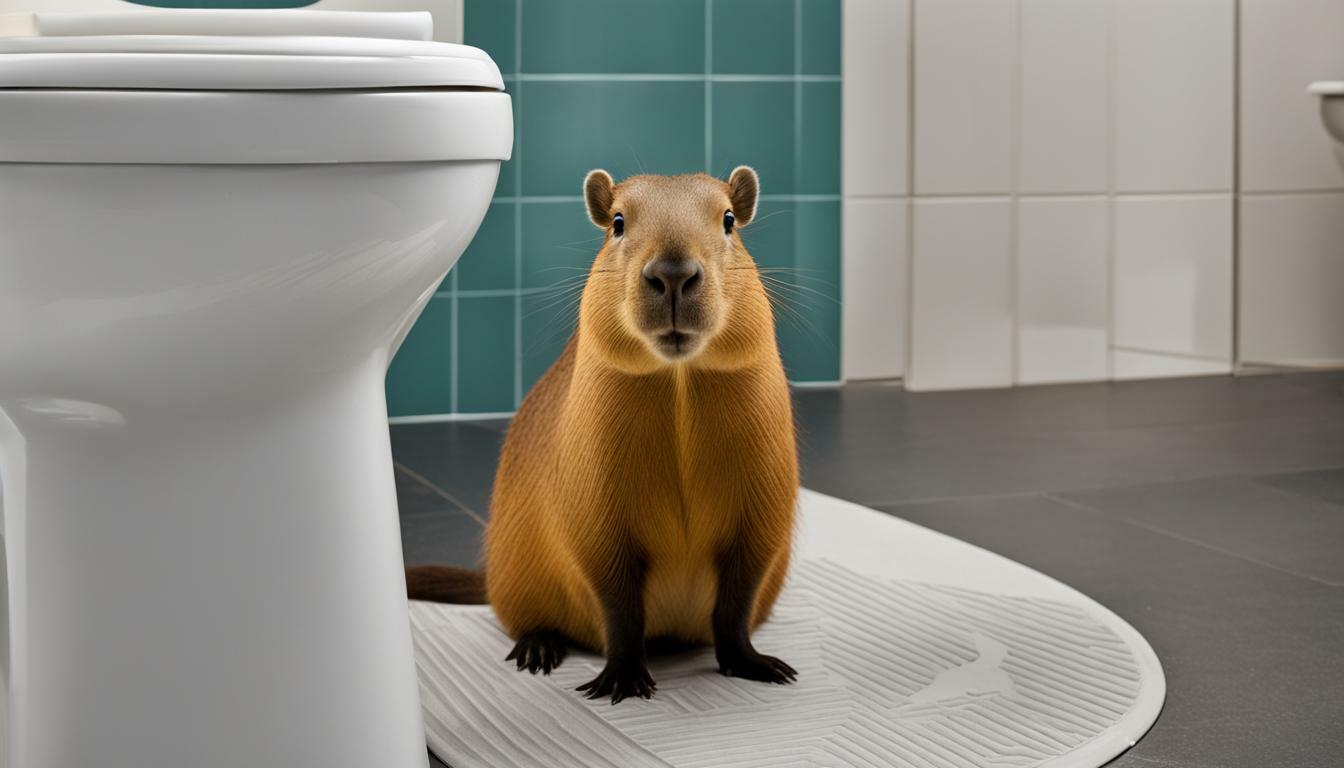If you’re wondering whether capybaras can be potty trained, read on to discover the answer. Potty training capybaras is indeed possible and can be achieved with patience and consistency. While it may be more challenging to train adult or old capybaras compared to baby capybaras, it is not impossible. Potty training capybaras is similar to training dogs or cats, but there are a few unique considerations to keep in mind.
Key Takeaways:
- Capybaras can be potty trained, but it may be more difficult with adult or old capybaras.
- Potty training capybaras is similar to training dogs or cats.
- Provide both wet and dry litter trays for capybaras.
- Consistently bring the capybara to the designated potty area for elimination.
- Use positive reinforcement, such as praise or treats, to encourage proper elimination behavior.
Training Techniques for Capybaras
When it comes to potty training capybaras, there are various techniques you can use to encourage proper elimination behavior. Potty training capybaras is similar to training dogs or cats, as it involves consistent reinforcement and positive associations with the designated potty area.
One effective technique is to provide both wet and dry litter trays for your capybara. Capybaras have a preference for eliminating in water, so having a shallow tray filled with water can serve as their designated potty spot. This can be complemented with a separate dry litter tray for land eliminations. By offering both options, you are accommodating their natural instincts and increasing the likelihood of successful potty training.
Positive reinforcement plays a crucial role in potty training capybaras. Using treats or verbal praise when the capybara eliminates in the designated area helps create a positive association. This encourages them to repeat the behavior in order to receive the reward. Consistency is key in reinforcing the desired behavior, so be sure to provide praise or treats immediately after they eliminate in the designated area.
| Training Techniques for Capybaras | Benefits |
|---|---|
| Providing both wet and dry litter trays | Accommodates capybaras’ preference for eliminating in water and allows for options on land |
| Positive reinforcement | Creates a positive association with the designated potty area |
Remember, potty training capybaras requires patience and consistency. Progress may take time, especially when training adult or old capybaras, but with the right techniques and reinforcement, you can achieve success. By implementing these training techniques and providing the necessary accommodations, you can effectively potty train your capybara and maintain a clean and hygienic environment for both you and your furry friend.
Steps to Successfully Potty Train a Capybara
To successfully potty train your capybara, follow these steps to establish a consistent routine:
- Designate a specific area for your capybara’s potty needs. This can be a litter tray, a specific corner of their enclosure, or an outdoor potty area. Ensure there is easy access to this area for your capybara.
- Observe your capybara’s behavior and learn their signs of needing to eliminate. These signs may include sniffing around, circling, or becoming restless. When you notice these signs, gently guide your capybara to the designated potty area.
- Use positive reinforcement techniques to encourage proper elimination behavior. When your capybara uses the designated potty area, praise them and offer a small treat. This will reinforce the association between using the potty area and receiving rewards.
- Be patient and consistent with the training. It may take time for your capybara to fully grasp the concept of potty training. Stick to a regular schedule, bringing your capybara to the potty area at designated times throughout the day.
Remember to clean up the potty area regularly to maintain hygiene. Remove any waste and replace litter or bedding as necessary. This will help keep the area clean and prevent odors.
Keep in mind that capybaras may have individual preferences for eliminating on land or in water. If your capybara shows a preference, provide options for both. For example, you can have a litter tray on land and a shallow water area for water elimination. This will allow your capybara to choose their preferred spot.
Additional Tips:
If you are potty training an adult or old capybara, be aware that it may take longer for them to learn compared to baby capybaras. Be patient and adjust your training techniques as needed to suit their age and abilities.
| Steps | Description |
|---|---|
| Designate a specific area | Choose a designated area for your capybara’s potty needs, such as a litter tray or a corner of their enclosure. |
| Observe behavior | Watch for signs that your capybara needs to eliminate, and gently guide them to the designated potty area. |
| Use positive reinforcement | Praise and reward your capybara when they use the potty area to reinforce the desired behavior. |
| Be patient and consistent | Stick to a regular schedule and bring your capybara to the potty area at designated times throughout the day. |
By following these steps and adapting them to your capybara’s individual needs, you can establish a successful potty training routine. Remember, patience and consistency are key to effectively train your capybara.
Providing Wet and Dry Litter Trays
Capybaras have different preferences when it comes to litter trays, so it’s essential to provide both wet and dry options. These options allow capybaras to choose their preferred method of elimination, ultimately promoting a successful potty training experience.
Wet litter trays should be filled with water, mimicking the capybara’s natural instinct to eliminate in water. This can be achieved by using shallow containers or even plastic kiddie pools. The water level should be kept low to ensure easy access for the capybara. It’s important to regularly change and clean the water to maintain hygiene and prevent odors.
Dry litter trays can be filled with materials such as hay, straw, or shredded paper. Capybaras may prefer this option if they are uncomfortable eliminating in water. The litter should be changed frequently to maintain cleanliness. Additionally, placing some of the capybara’s feces or urine-soaked bedding in the dry litter tray can help encourage the capybara to use it.
| Litter Tray Type | Advantages | Disadvantages |
|---|---|---|
| Wet Litter Trays | Matches capybara’s natural instinct, easy to clean | Requires regular water changes, potential for increased humidity |
| Dry Litter Trays | Comfortable for capybaras, easy to maintain | May not match capybara’s instinct, requires frequent litter changes |
It’s worth noting that some capybaras may prefer one type of litter tray over the other, while others may use both. Observing the capybara’s behavior and monitoring their preferences will help determine which option is favored. Providing multiple trays in different locations can also be beneficial, giving the capybara the freedom to choose the most comfortable spot to eliminate.
Positive Reinforcement for Potty Training
Positive reinforcement is a powerful tool when it comes to potty training capybaras – learn how to use it effectively. Similar to training dogs or cats, capybaras respond well to praise and rewards. By associating the desired behavior with positive experiences, you can encourage your capybara to use the designated potty area consistently.
One effective technique is to use treats as a reward. Whenever your capybara successfully eliminates in the desired area, immediately provide a treat and offer verbal praise. This positive reinforcement creates a strong association between the desired behavior and the reward, motivating the capybara to repeat the behavior in the future.
Consistency is key when using positive reinforcement. Ensure that you always reward your capybara immediately after they eliminate in the designated potty area. By consistently associating the reward with the desired behavior, you reinforce the capybara’s understanding of what is expected of them.
| Tip | Example |
|---|---|
| Use high-value treats | Offer small pieces of their favorite fruits or vegetables, such as watermelon or carrots. |
| Be patient and consistent | Continue to provide positive reinforcement every time your capybara successfully uses the potty area, regardless of age or previous training progress. |
| Combine verbal praise with treats | In addition to providing a treat, use a positive and enthusiastic tone to praise your capybara for their good behavior. |
By using positive reinforcement and consistently rewarding your capybara for using the designated potty area, you can effectively potty train them. Remember to be patient and consistent throughout the training process. With time and effort, you can help your capybara develop good elimination habits and maintain a clean living environment.
Cleaning Up After Your Capybara
Properly cleaning up after your capybara is essential for maintaining a hygienic living space. Capybaras, like many other pets, can create a mess in their surroundings. Regular cleaning not only keeps the environment clean and odor-free but also promotes the capybara’s overall health and well-being.
When it comes to cleaning up after your capybara, start by removing any solid waste from their living area using a scoop or shovel. Dispose of the waste in a designated area or bag to minimize odor and potential contamination. Follow this up by wiping down any surfaces or platforms with a pet-safe disinfectant, ensuring all traces of waste and bacteria are eliminated.
“Regular cleaning not only keeps the environment clean and odor-free but also promotes the capybara’s overall health and well-being.”
In addition to solid waste, capybaras may also leave behind wet waste, which requires special attention. You can provide your capybara with a shallow pool or a designated wet area for elimination. Make sure to clean and replace the water regularly to prevent the buildup of bacteria and algae. Proper filtration systems can help maintain the cleanliness of the pool or wet area, ensuring your capybara’s comfort and health.
To summarize, cleaning up after your capybara involves removing solid waste, disinfecting surfaces, and maintaining a clean wet area if applicable. Regular cleaning not only ensures a hygienic living space but also reduces the risk of potential health issues for your capybara. Remember to use pet-safe cleaning products and create a cleaning routine that fits your capybara’s needs.
Accommodating Capybara Elimination Preferences
Capybaras may have their own preferences when it comes to eliminating, and as their caretaker, it’s important to accommodate these preferences. Some capybaras may prefer to eliminate on land, while others may prefer to do so in water. To ensure their comfort and well-being, it’s essential to provide options for both land and water elimination areas.
Land Elimination: To accommodate capybaras that prefer eliminating on land, create a designated potty area with absorbent litter. This can be a shallow litter tray filled with hay, grass, or even special capybara-friendly litter. Place the tray in an easily accessible location where the capybara can reach it comfortably. Choose a spot away from their sleeping or eating areas to maintain cleanliness.
Water Elimination: For capybaras that prefer eliminating in water, provide a shallow pool or large container filled with clean water. This allows the capybara to have a dedicated water area for elimination. Keep in mind that the water should be regularly cleaned and filtered to maintain hygiene.
By offering both land and water elimination options, you can cater to the capybara’s natural preferences and ensure their overall comfort. Remember to observe their behavior and adjust the potty areas accordingly. Consistency is key, and with patience and understanding, you can establish a successful potty routine that works for both you and your capybara companion.
| Land Elimination | Water Elimination |
|---|---|
| Create a designated potty area with absorbent litter. | Provide a shallow pool or large container filled with clean water. |
| Place the tray in an easily accessible location. | Regularly clean and filter the water. |
| Choose a spot away from sleeping or eating areas. | Observe capybara behavior and adjust potty areas accordingly. |
Potty Training Adult and Old Capybaras
Potty training adult or old capybaras may require some adjustments to the training process. Unlike baby capybaras, who are more receptive to learning new behaviors, adult or old capybaras may have established habits that are harder to break. However, with patience and consistency, it is still possible to potty train them successfully.
One important adjustment is to understand that adult or old capybaras may take longer to grasp the concept of potty training. They have likely developed their own patterns and preferences over time. It is essential to be patient and understanding as they adjust to the new training routine.
In addition to patience, consistency is key when potty training adult or old capybaras. Establish a designated potty area and bring the capybara to the area regularly. Use positive reinforcement techniques, such as praise or treats, to encourage them to use the designated area for elimination. Consistently rewarding desired behavior will help reinforce the training and improve the chances of success.
To successfully potty train adult or old capybaras, consider the following tips:
- Adapt the training techniques to suit their individual needs and preferences.
- Provide both wet and dry litter trays to accommodate their preferences.
- Keep the potty area clean and odor-free to encourage proper elimination behavior.
- Be patient and consistent, as progress may take longer compared to training baby capybaras.
| Tip | Example |
|---|---|
| Adapt the training techniques | Observe their behavior and adjust the training methods accordingly. |
| Provide both wet and dry litter trays | Offer a variety of litter options to cater to their preferences. |
| Keep the potty area clean | Regularly clean the litter trays and surrounding area to maintain hygiene. |
| Be patient and consistent | Continue the training process with a positive attitude, even if progress is slow. |
Remember, potty training adult or old capybaras may require more time and effort, but with the right approach, it can be achieved. By making adjustments to the training techniques, providing consistent reinforcement, and maintaining a clean environment, you can overcome the challenges and successfully potty train your capybara.
The Importance of Patience and Consistency
Patience and consistency are key when it comes to potty training capybaras. While it may be more challenging to train adult or old capybaras compared to baby capybaras, with the right approach and dedication, it is possible to achieve success.
Potty training capybaras follows similar principles to training dogs or cats. It is important to establish a routine and provide clear cues for the capybara to understand where they should eliminate. Consistency in bringing them to the designated potty area and using positive reinforcement techniques can help reinforce their training.
Providing both wet and dry litter trays is vital for capybaras, as they may have preferences for a specific type of substrate. Some capybaras prefer to eliminate on land, while others may prefer to do so in water. Giving them options for both can help accommodate their individual preferences and increase the chances of successful potty training.
Cleanliness is crucial when potty training capybaras. Regularly cleaning the potty area and removing waste promptly can help maintain hygiene and prevent odors. Capybaras are naturally clean animals, and a clean environment can contribute to their successful potty training.
| Key Takeaways |
|---|
| Patience and consistency are crucial when potty training capybaras. |
| Training capybaras requires establishing a routine and providing clear cues. |
| Positive reinforcement, such as praise or treats, can help reinforce desired behavior. |
| Providing both wet and dry litter trays can accommodate capybaras’ elimination preferences. |
| Maintaining cleanliness is important for successful potty training. |
Conclusion
Potty training capybaras is indeed possible with effective methods and consistent training. While it may be more challenging to train adult or old capybaras compared to baby capybaras, it is still possible to teach them proper elimination behavior. Similar to training dogs or cats, capybaras can be trained to use a designated potty area.
Providing both wet and dry litter trays is essential for accommodating the capybara’s preferences. Some capybaras may prefer one over the other, so having both options available can help encourage them to use the designated potty area. Consistently bringing the capybara to the designated area for elimination and using positive reinforcement, such as praise or treats, can also help reinforce the desired behavior.
Maintaining hygiene is crucial when potty training capybaras. Cleaning up after the capybara and properly cleaning the potty area can help prevent odors and ensure a clean environment for both the capybara and its owner. Capybaras may have different elimination preferences, with some preferring to eliminate on land and others in water. Offering options for both can allow the capybara to choose their preferred spot.
Patience and consistency are key when potty training capybaras. Progress may take time, especially with adult or old capybaras, but with consistent effort and effective training techniques, capybaras can learn to use a designated potty area. By providing the necessary resources, positive reinforcement, and maintaining a clean environment, capybaras can be successfully potty trained.
FAQ
Can capybaras be potty trained?
Yes, capybaras can be potty trained, although it may be more difficult to train adult or old capybaras compared to baby capybaras.
Is potty training capybaras similar to training dogs or cats?
Yes, potty training capybaras is similar to training dogs or cats.
What are the key steps for potty training a capybara?
The key steps for potty training a capybara include providing wet and dry litter trays, consistently bringing the capybara to the designated potty area, using positive reinforcement, and maintaining cleanliness.
Should both wet and dry litter trays be provided for capybaras?
Yes, it is important to provide both wet and dry litter trays for capybaras.
How can positive reinforcement be used in potty training capybaras?
Positive reinforcement can be used in potty training capybaras by praising or rewarding them with treats when they use the designated potty area.
How do you clean up after a capybara?
It is important to clean up after a capybara to maintain hygiene. This involves properly disposing of waste and cleaning the potty area to prevent odors.
Should capybaras be provided with options for elimination on land or in water?
Yes, capybaras may prefer to eliminate on land or in water, so it is helpful to provide options for both.
Is potty training adult or old capybaras more challenging?
Potty training adult or old capybaras may be more challenging compared to baby capybaras.
What is the importance of patience and consistency in potty training capybaras?
Patience and consistency are key in potty training capybaras. Progress may take time, but with consistent effort, it can be achieved.




